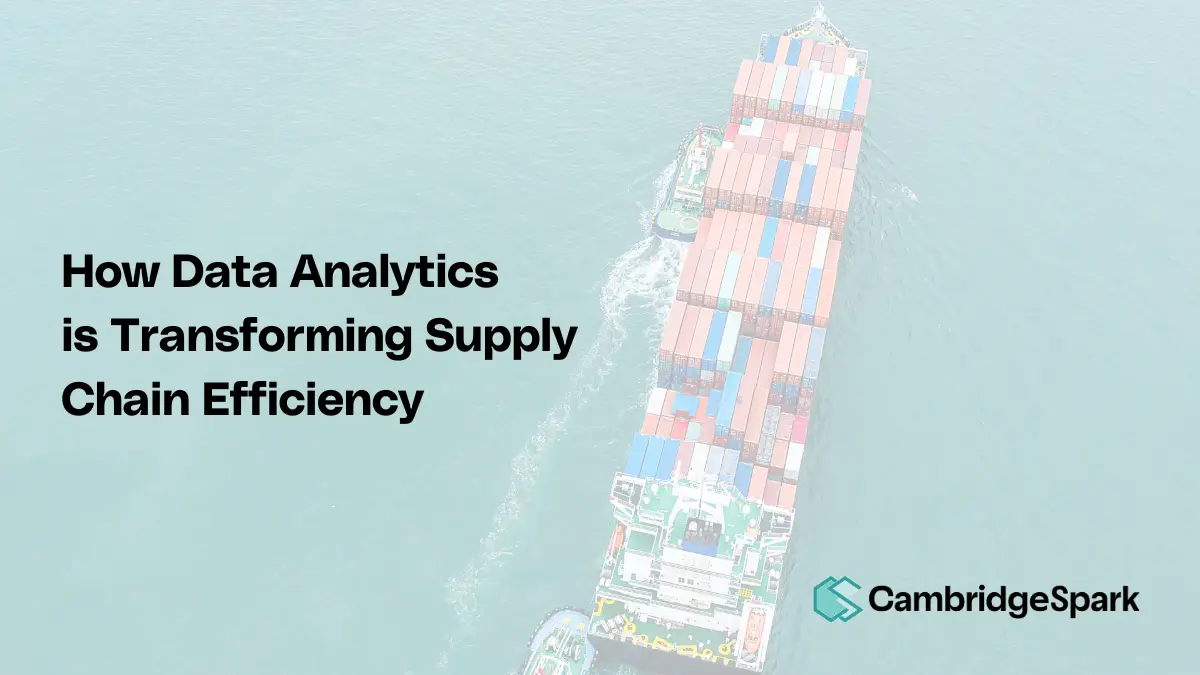Supply chain optimisation may not be the first, or the sexiest, approach that springs to mind when we consider how to improve a business..
Yet, according to a report by Accenture, a global retailer increased its profits by 28% in just 3 years by digitising its supply chain process.
The efficiency of supply chain operations is a pivotal factor for success within any business today. And supply chain analytics offers insights and capabilities that were unimaginable a few decades ago.
Let’s uncover the transformative impact of analytics on supply chain efficiency.
What is supply chain analytics?
Supply chain analytics is the process of collecting, analysing, and interpreting data related to supply chain activities. This includes everything from sourcing raw materials to delivering finished products to customers.
A growing number of organisations recognise the power of data-driven insights. They see the potential for these to raise efficiency, cut costs and improve customer satisfaction.
Next look at the difference between traditional supply chain management and more data-driven analytics.
Traditional methods of supply chain management
Until recently, supply chain management largely relied on historical data and intuitive decision-making. This approach often lacked the precision needed to navigate the complexities of modern supply chains.
Organisations often made decisions by interpreting data patterns gathered over extended periods of time. This process involved many departments, each armed with their own, sometimes conflicting, sets of data.
As a result, the initial step in decision-making usually meant holding consensus meetings to align on which data to use for critical supply chain decisions.
-1.webp?width=1050&height=591&name=Blog%20images%20(2)-1.webp)
It’s easy to see how this approach was both inefficient and maladaptive.. Organisations wasted precious time in reaching consensus. And decisions were often made using outdated data that no longer reflected their current supply chain.
This also meant supply chain professionals responding reactively, rather than proactively, to any disruptions. Although effective in a more stable and predictable market, this often led to inefficiencies, such as overstocking or understocking and the inability to react quickly to disruptions.
Enter the era of big data and advanced analytics.
Modern methods of supply chain management using analytics
Whereas earlier methods for managing supply chains were less reliable and efficient, advanced analytics has helped professionals make far better decisions.
Supply chain analytics harnesses the power of real-time data, complex analytical tools, and predictive modelling. It provides a more proactive approach to supply chain management than traditional methods.
Artificial Intelligence (AI) and machine learning (ML) are giving professionals powerful tools for supply chain optimisation. These technologies allow more sophisticated analysis and interpretation of large data sets. And this leads to more accurate predictions and smarter decision-making.
But it’s not just AI and ML working to transform supply chains. Real-time analytics provides immediate insights into supply chain operations, enabling quick responses to changing conditions. This immediacy is crucial for maintaining an efficient and responsive supply chain in a rapidly changing environment.
Supply chain analytics is also allowing for predictive and prescriptive decision-making. Both are data analysis techniques that enable more effective supply chain management.
- Predictive analytics uses statistical models and forecasting techniques to understand the likelihood of future outcomes. This helps businesses prepare for potential supply chain disruptions.
- Prescriptive analytics goes a step further by not only predicting what might happen but also suggesting actions to achieve desired outcomes. For example, it can recommend the optimal inventory levels for different products based on predicted demand, seasonality, and market conditions.
The transition from traditional methods to analytics driven supply chain management isn't just a change in technology. It represents a fundamental shift in the strategic approach to supply chain optimisation.
This strategy is more aligned with the dynamic and interconnected nature of today's global business environment.
Applications of analytics in supply chain functions
Let's take a look at specific ways you might use analytics to better manage your supply chain:
Inventory management
Analytics is often helpful in inventory management by investigating and informing your team on the state of your company’s stock levels. It allows for a more dynamic approach to inventory control and accounts for various factors like seasonal demand, market trends, and supply chain disruptions.
-1.webp?width=1050&height=591&name=inventory%20management%20(1)-1.webp)
Take Martyna Jones for example, Data Analytics Manager at M&S. After completing a Level 4 Data Analytics Apprenticeship in July 2021, she helped M&S optimise their supply chain management.
Historically, M&S would replenish their inventory levels each time a customer purchased a product. By developing an optimisation model, Martyna was able to create a process that allowed warehouse staff to replenish more products less often.
This led to a much more efficient way of working whilst ensuring continued availability of products.
Predictive analytics takes demand forecasting to a new level. It uses algorithms and machine learning to predict future demand of your products. This advanced form of analytics can identify patterns and trends that humans might miss, making demand planning more precise.
Identifying and mitigating risks
Supply chain professionals can often apply analytics to identify potential risks. Analysing data from various sources, can reveal vulnerabilities in your supply chain, so you can intervene before they become critical problems.
Luke Kay is a Data Analyst at Exertis. Exertis is one of the UK’s largest and fastest growing technology distribution and specialist service providers. Luke used his learnings from the Level 4 Data Analyst Apprenticeship and applied them to the organisation’s stock management processes.
By reporting on stock conditions, he now helps those responsible for stock management to understand stock location, activities, and identify which stock-keeping units (SKUs) are potentially at risk.
-1.webp?width=1050&height=591&name=Blog%20images%20(1)-1.webp)
Using predictive models
By analysing historical data, market research, and real-time inputs, predictive models can forecast a range of potential disruptions such as:
- Supplier insolvency: Predictive analytics can assess the financial health of suppliers by analysing financial reports and credit scores helping to identify risky suppliers.
- Transportation delays: Transportation is a critical, yet vulnerable, component of the supply chain. Predictive models analyse data, such as traffic patterns, weather forecasts, and historical shipment data, to anticipate potential delays.
Companies can use this information to adjust their transportation strategies, perhaps by pre-emptively re-routing shipments or adjusting schedules to maintain timely deliveries.
- Geopolitical events: Global supply chains can be significantly affected by geopolitical instability. Predictive analytics tools have the ability to track global news, economic indicators, and social media trends to forecast geopolitical risks.
This early warning system enables companies to assess the potential impact on their supply chain operations. It helps them develop contingency plans, such as stockpiling inventory or identifying alternative markets.
- Natural disasters: Predictive models use weather data and historical patterns to forecast natural disasters.
These forecasts allow companies to prepare in advance, be it by moving inventory, securing alternative transportation routes, or implementing emergency response protocols. In this way, they’re able to minimise the impact of such events on their supply chain.
This proactive approach towards risk mitigation using predictive models, ensures that companies can stay one step ahead and prepare, should the worst happen!
Monitoring environmental footprint
A staggering 88% of consumers show greater loyalty to companies that support social or environmental issues.
Supply chain analytics plays a key role in an organisation’s sustainability efforts. By analysing data related to carbon emissions, waste management, and resource use, you can identify areas for environmental improvement. You can then take steps to reduce your ecological footprint.
For example, you might use analytics to compare the carbon emissions of different transportation methods. This helps guide decisions to optimise logistics to achieve lower environmental impact.
Not only that, data acts as concrete evidence when shouting about your sustainability efforts. Which is great for your brand's marketing strategy!
By sharing data-driven insights and achievements in sustainability, you can effectively communicate your commitment to environmental stewardship. This can foster stronger customer relationships and enhances your brand's reputation.

Conclusion
Supply chain analytics has emerged as a transformative force in modern business, reshaping how organisations approach supply chain efficiency. The integration of advanced techniques such as artificial intelligence, machine learning and real-time analytics has revolutionised traditional supply chain management practices.
By harnessing these technologies, your business can achieve unprecedented levels of optimisation, responsiveness, and sustainability.
If you’re interested in how you can apply data analytics to your supply chain role, please get in touch with us via the form below.

-1.png)

-1.webp?width=1050&height=591&name=Blog%20images%20(2)-1.webp)
-1.webp?width=1050&height=591&name=inventory%20management%20(1)-1.webp)
-1.webp?width=1050&height=591&name=Blog%20images%20(1)-1.webp)
